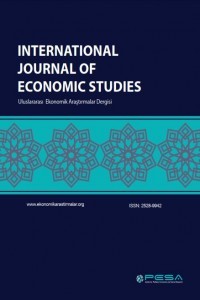Cost of Health Care and Utilization of Emergency Departments in Turkey
Cost of Health Care and Utilization of Emergency Departments in Turkey
Free Emergency Department Visits, Emergency Department Utilization, Diseases and Accidents Blinder-Oaxaca,
___
- Andrulis DP, Kellermann A, Hintz EA, Hackman BB, Weslowski VB. Emergency departments and crowding in United States teaching hospitals. Annals of emergency medicine 1991; 20(9): 980-6.
- Ataman K, Beril K, Öncü MR, Tuğrul F. Bir devlet hastanesi acil servisine başvuran hastaların profili ve başvurunun uygunluğu. Gaziantep Medical Journal 2011; 17(2): 57-62.
- Atun R, Aydın S, Chakraborty S, et al. Universal health coverage in Turkey: enhancement of equity. The Lancet 2013; 382(9886): 65-99.
- Baker LC, Baker LS. Excess cost of emergency department visits for nonurgent care. Health Affairs 1994; 13(5): 162-71.
- Bianco A, Pileggi C, Angelillo IF. Non-urgent visits to a hospital emergency department in Italy. Public health 2003; 117(4): 250-5.
- Blinder AS. Wage discrimination: reduced form and structural estimates. Journal of Human resources 1973: 436-55.
- Davidson SM. Understanding the growth of emergency department utilization. Medical care 1978: 122-32.
- Daymont TN, Andrisani PJ. Job preferences, college major, and the gender gap in earnings. Journal of Human Resources 1984: 408-28.
- Ding R, McCarthy ML, Li G, Kirsch TD, Jung JJ, Kelen GD. Patients who leave without being seen: their characteristics and history of emergency department use. Annals of emergency medicine 2006; 48(6): 686-93.
- Eroglu SE, Toprak SN, Urgan O, et al. Evaluation of non-urgent visits to a busy urban emergency. Saudi Med J 2012; 33(9): 967-72.
- Gordon JA, Billings J, Asplin BR, Rhodes KV. Safety net research in emergency medicine proceedings of the academic emergency medicine consensus conference on “The Unraveling Safety Net”. Academic Emergency Medicine 2001; 8(11): 1024-9.
- Grumbach K, Keane D, Bindman A. Primary care and public emergency department overcrowding. American Journal of Public Health 1993; 83(3): 372-8.
- Hock MOE, Ornato JP, Cosby C, Franck T. Should the emergency department be society's health safety net? Journal of public health policy 2005; 26(3): 269-81.
- Jann B. The Blinder-Oaxaca decomposition for linear regression models. The Stata Journal 2008; 8(4): 453-79.
- Jones FL, Kelley J. Decomposing differences between groups: A cautionary note on measuring discrimination. Sociological Methods & Research 1984; 12(3): 323-43.
- McCaig LF, Nawar EW. National hospital ambulatory medical care survey: 2004 emergency department summary: US Department of Health and Human Services, Centers for Disease Control and Prevention, National Center for Health Statistics; 2006.
- Oaxaca R. Male-female wage differentials in urban labor markets. International economic review 1973: 693-709.
- Oktay C, Cete Y, Eray O, Pekdemir M, Gunerli A. Appropriateness of emergency department visits in a Turkish university hospital. Croatian medical journal 2003; 44(5): 585-91.
- Rowe BH, Channan P, Bullard M, et al. Characteristics of patients who leave emergency departments without being seen. Academic Emergency Medicine 2006; 13(8): 848-52.
- Trzeciak S, Rivers E. Emergency department overcrowding in the United States: an emerging threat to patient safety and public health. Emergency medicine journal 2003; 20(5): 402-5.
- Winsborough H, Dickinson P. Components of negro-white income differences. Age 1971; 25(34): 35-44.
- ISSN: 2528-9942
- Başlangıç: 2015
- Yayıncı: Politik Ekonomik ve Sosyal Araştırmalar Merkezi
Akif Ziya BAYRAK, Kezban CİHAN, Mustafa Uğur MİRASEDOĞLU, Önder DİLEK
Orta Sınıf Analizleri: Teorik Bir Yaklaşım
Cost of Health Care and Utilization of Emergency Departments in Turkey
Kurumsal Aboneler Açısından Türkiye Mobil İletişim Piyasası
Türkiye İşgücü Piyasasının Değerlendirilmesi ve Ulusal İstihdam Stratejisi Hedefleri İle Uyumu
Abdülkadir ALTINSOY, Yunus YİĞİT
Suriyeli Sığınmacıların Türk Emek Piyasasına Etkileri Fırsatlar ve Tehditler
Gelirin Optimal Vergilendirilmesi: Teori ve Politika
Enerji Bağımsızlığı İçin Temiz Kömür Teknolojileri: Türkiye Üzerine Bir Uygulama
Öz-Yeterlilik ve Değişime Karşı Direncin Girişimcilik Eğilimi Üzerine Etkisi
